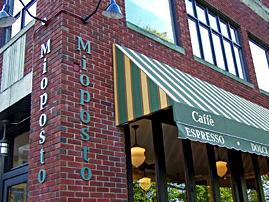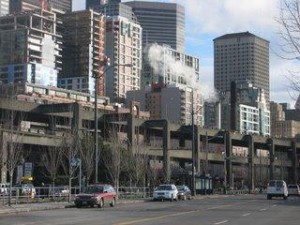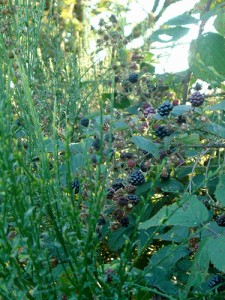Friday, August 15: Bandersnatches
MYSTERY PLACES
by Steve Steinbock
 I’m sitting at Mio Posto, a corner café and pizzeria in the Mount Baker neighborhood of Seattle. Long time Criminal Brief readers may remember that I spent a lot of time here last summer when I was on the west coast visiting my sisters.
I’m sitting at Mio Posto, a corner café and pizzeria in the Mount Baker neighborhood of Seattle. Long time Criminal Brief readers may remember that I spent a lot of time here last summer when I was on the west coast visiting my sisters.
There are three guys behind the corner, all wearing black t-shirts, two with bandanas wrapped around their foreheads, and the third wearing a baseball cap pulled backwards over his head. One is slicing beets. The second is tossing pizza dough in the air, and the third is wiping down the counter. All three are singing “Cecilia” along with Simon and Garfunkel. The wood fire of the brick oven is wafting its smoky aroma. Photographs of Italian waterfronts line one wall.
I’m immediately at home, and conscious of the importance of setting in good writing. Setting is mostly about locations. It includes architecture, climate, flora, fauna, cultural elements, and more. But getting the setting right in something intangible. When I think of place in fiction, Tony Hillerman is the author who comes to mind. No one pulls off a sense of locale like him when he writes his Navajo cop mysteries. The geographical and geological environment, the culture, the very dust of the place comes alive in his writing.
 I haven’t read J.A. Jance in a number of years, but I have fond memories of identifying her crime scenes with places I haunted during my own misspent youth. My buddies and I would sneak off into the woods at the southern tip of Seattle’s Lake Union, a spot where Jance set a construction site murder. Another murder took place near the mouth of the Alaska Way Viaduct, where my friends and I would bring our beer and wait for the earthquaking rumble of trains emerging beneath us.
I haven’t read J.A. Jance in a number of years, but I have fond memories of identifying her crime scenes with places I haunted during my own misspent youth. My buddies and I would sneak off into the woods at the southern tip of Seattle’s Lake Union, a spot where Jance set a construction site murder. Another murder took place near the mouth of the Alaska Way Viaduct, where my friends and I would bring our beer and wait for the earthquaking rumble of trains emerging beneath us.
Countercultural author Tom Robbins once wrote about the blackberry brambles that dominate the Seattle landscape. He once said that if humanity disappeared from the area, blackberry bushes would overtake the entire region. It’s true. We went for a drive yesterday and everywhere we travelled, there were walls of fruity filled sticker bushes lined the neighborhood hillsides.
When I was a teenager, I was with some friends atop a hill overlooking Lake Washington. My friend Grant took up a long stick and held it like a javelin.
“Look guys!” he said as he ran toward the edge of the hill. He prepared to toss his spear and then was gone.
“Guys?” we heard him say. But he was nowhere in sight.
“Guys? I’m down here. Can you help me out?”
 Poor Grant was suspended in a twenty-foot high blackberry bush that ran up the side of the hill. The solid edge of the hill merged with blackberries, and Grant had misjudged where earth ended and blackberries began. Still grasping his spear, he couldn’t move. I don’t remember how we unattached him from the stickers, but we did. At least I don’t think he’s still there. In the blackberries of Seattle, one never knows.
Poor Grant was suspended in a twenty-foot high blackberry bush that ran up the side of the hill. The solid edge of the hill merged with blackberries, and Grant had misjudged where earth ended and blackberries began. Still grasping his spear, he couldn’t move. I don’t remember how we unattached him from the stickers, but we did. At least I don’t think he’s still there. In the blackberries of Seattle, one never knows.




















Good column and welcome to Seattle, Steve. Sorry I couldn’t be there to cover your path with rose petals. Make sure you visit the Seattle Mystery Bookshop near Pioneer Square.
Do you know that Akashic is putting out Seattle Noir next spring? Do you know it will be 90 freaking degrees in the Emerald City today?
It’s 10:am in the Emerald City and it already feels like 95 degrees.
A Seattle Noir book sounds great. Akashic has been doing wonderful regional anthologies.
In my column, I should have mentioned the lavender. I’ve never noticed it before, but there seems to be lavender growing in everyone’s yard. I’m botanically illiterate, but local flora does add a lot to the flavor of writing. My sister has foxglove growing wild in her yard. I think there may be a mystery in there somewhere.
Blackberries made up a significant part of my youthful outdoor experience. Mother used to make pie and jam out of them — the best berries in the world for making desserts. We lived on a small, Puget Sound island in Tacoma, 30 miles south of Seattle, and Mom took all the kids berry picking with her. I’m not sure if it was because she couldn’t afford a baby sitter or because we really picked enough berries to make a difference.
The berries have three defenses against being harvested. The vines have vicious thorns, and the biggest fruits always hung way back in there. Running a tender hand through the leaves was an act of self-sacrifice, making the every bite of the delicious, purple pie worth the vicious scratches and stabs. The second defense was from nettles, a wild vine armed with natural hypodermic needles capable of injecting poison into the skin from just a casual brush with the hand. Nettles seemed to have an alliance with blackberry bushes. The third defense was bees, only there to collect the nectar from the flowers, but not always willing to share the space with human beings.
Ethel Devish was an adult friend of ours who lived in town, but knew the call of the wild like an Eagle Scout. She was also an expert and experienced practical joker. Once she offered me a glass of root beer, and I drank a big swig. It was the juice she had just decanted from a can of black olives. After a trip to the seashore, we were removing the ovaries from sea urchins to dry and display their hollow skeletons. Over a sink of the slimy, orange offal, Ethel told me that the Japanese considered them a delicacy. Feeling safe in my dare, I said, “I’ll eat one if you will.” Ethel picked a giant lump from the sink and popped in into her mouth, swallowed it, and smiled as she waited for me to pay for my words. Ethel was NOT like my mother.
One day we were picking blackberries with Ethel. My hand basket was getting full, and I told Ethel I was going to walk out to the road to empty it into a large tub by the car. Ethel warned me, “What if someone else comes along and decides to pick their berries out of your tub?” I said, now knowing her sense of humor very well, “Oh, I’ll just put a note on top saying I spit on these.” Ethel said, “Well, what if you come back and find another note saying ‘We spit on them, too.’ ”
to ja: funny you should mention the largest best to eat berries are always at the top as our oldest mentioned that the other day while we were househunting;-) He then reminded me how I destroyed the wild blackberries growing in our yard in Maine. I then reminded him that they are growing back up underneath the rocks already. Berries never die;-)
Nice column hubs; I now understand why you visit Mio Posto daily.
Ah – Steve.
You’ve touched on a key element of storytelling–
the setting.
The finesse to drape atmosphere over the senses so the reader is there is a tricky task.
I am originally from Bellingham (90 mi. north of Seattle) but now live in Alaska, and I too love reading writers from Seattle/Pacific Northwest.
JA Jance & Earl Emerson are two of my favorite Seattle authors.
I love to read where they’re tromping for I know those areas and it brings me back home.
Dana Stabenow and John Straley are my favorite Alaskan crime authors.
Thanks for the picture of the blackberries – boy did I love those. And the salmon berries. And huckleberries.
When I was down to visit in June, the fruit trees weren’t heavy with ripe fruit yet nor were the berry bushes. Next year I’ll aim for August.
Kim!
If you are following Criminal Brief then you’ll be learning in the next few days that I’m in your neck of the woods now. It was a pleasure to read your comment while sitting in an Alaskan cafe.